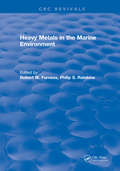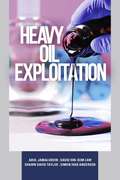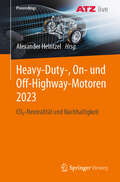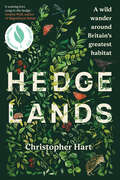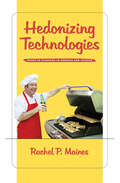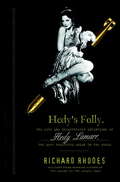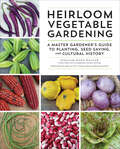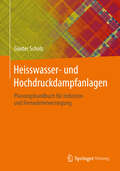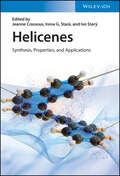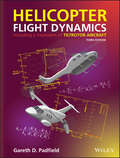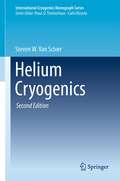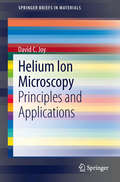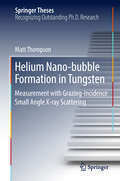- Table View
- List View
Heavy Metals in the Marine Environment
by Robert W. FurnessThe aim of this volume is to draw together state-of-the-art reviews of knowledge onlevels of heavy metals in marine environments (particularly in marine animals), the dynamicprocesses in these systems, toxic effects, and threats presented by heavy metals in foods ofmarine origin.All heavy metals, whether biologically essential or not, have the potential to be toxicto organisms at a threshold bioavailability. Such threshold concentrations vary betweenmetals, between species and with the physicochemical characteristics of the medium, somelike copper being particularly toxic even though essential in trace amounts. Responses ofanimals to metals in their medium or food depend to a large extent on the ability of speciesto regulate levels attained in their tissues. Higher animals have the capacity to regulate levelsof many metals, while marine invertebrates can regulate some within certain limits. Whereanimals cannot regulate physiological levels of metals, an alternative strategy is to detoxifyand store metals in relatively harmless forms. Knowledge of the manner in which animals deal with potentially toxic concentrations of heavy metals is of fundamental importance in the assessment of metal pollution by analysis of metal levels in biological samples. The interaction of heavy metals with biological materials is a key theme running through this volume. Toxic effects may be reflected at the individual, population, or ecosystem level, affecting species composition and production levels, or may be of direct dietary significance to man. The global cycling of metals through the marine environment is crucially affected by biological processes.
Heavy Oil Exploitation
by Abdul Jamaluddin David Hin-Sum Law Shawn David Taylor Simon Ivar AndersenHeavy crude oils have a unique chemical nature that creates many technical challenges. In this new book, four heavy oil and bitumen experts deliver a comprehensive look at the complexities of this alternative petroleum resource. With its high viscosity and complex hydrocarbon chemistry, heavy oil requires technical personnel to use innovative approaches to enable it to flow in a porous formation and also in the production circuit and finally to treat and convert it into valuable products. While plentiful deposits exist throughout the world, this heavy hydrocarbon requires upgrades in skill and process to extract, transport, and refine. KEY FEATURES: Characteristics of heavy oil Traditional and newest recovery methods Construction and completion of a heavy oil well A discussion of gas lifting, pumping systems, and sand management Unique transportation and processing requirements Overview of upgrading and refining requirements
Heavy Weather
by Bruce SterlingA near-future eco-thriller from the bestselling author of Schismatrix Plus and The Difference Engine. The Storm Troupers are a group of weather hackers who roam the plains of Texas and Oklahoma, hopped up on adrenaline and technology. Utilizing virtual reality, flying robots, and all-terrain vehicles, they collect data on the extreme storms ravaging an America decimated by climate change. But even their visionary leader can&’t predict the danger on the horizon when a volatile new member joins their ranks and faces a trial by fire: a massive tornado unlike any the world has seen before. &“A remarkable and individual sharpness of vision . . . Sterling hacks the future, and an elegant hack it is.&” —Locus &“Lucid and tremendously entertaining. Sterling shows once more his skills in storytelling and technospeak. A cyberpunk winner.&” —Kirkus Reviews &“So believable are the speculations that . . . one becomes convinced that the world must and will develop into what Sterling has predicted.&” —Science Fiction Age &“A very exciting coming-of-age story in a wild future America . . . What&’s it got? Cyberpunk attitude, genuine humor, nanotechnology, minimal sex but some cool medications and very big weather systems.&” —SFReviews.net &“Brilliant . . . Fascinating . . . Exciting . . . A full complement of thrills.&” —The New York Review of Science Fiction
Heavy-Duty-, On- und Off-Highway-Motoren 2021: Die Zukunft des Verbrennungsmotors und der alternativen Antriebe (Proceedings)
by Johannes LieblDie inhaltlichen Schwerpunkte des Tagungsbands zur ATZlive-Veranstaltung Heavy-Duty-, On- und Off-Highway-Motoren 2020 sind unter anderem neue Diesel- und Gasmotoren, Schadstoffreduzierung, Powertrain-Konzepte für den On- und Off-Highway-Bereich, Einspritzung sowie die Komponentenentwicklung im Hinblick auf das System. Die Tagung ist eine unverzichtbare Plattform für den Wissens- und Gedankenaustausch von Forschern und Entwicklern aller Unternehmen und Institutionen, die dieses Ziel verfolgen.Der InhaltDie ZielgruppenFahrzeug- und Motoreningenieure sowie Studierende, die aktuelles Fachwissen im Zusammenhang mit Fragestellungen ihres Arbeitsfeldes suchen - Professoren und Dozenten an Universitäten und Hochschulen mit Schwerpunkt Kraftfahrzeug- und Motorentechnik - Gutachter, Forscher und Entwicklungsingenieure in der Automobil- und ZulieferindustrieDer VeranstalterATZlive steht für Spitzenqualität, hohes Niveau in Sachen Fachinformation und ist Bestandteil der Springer Fachmedien Wiesbaden GmbH, ein Teil von Springer Nature. Hier wird unter einem Dach das Know-how der renommiertesten Wirtschafts-, Wissenschafts- und Technikverlage Deutschlands vereint.
Heavy-Duty-, On- und Off-Highway-Motoren 2022: Stand der Energiewende im Heavy-Duty-Bereich (Proceedings)
by Alexander HeintzelDie inhaltlichen Schwerpunkte des Tagungsbands zur ATZlive-Veranstaltung "Heavy-Duty-, On- und Off-Highway-Motoren 2022" sind unter der Überschrift "Stand der Energiewende im Heavy-Duty-Bereich" unter anderem Antriebe für zukünftige Kraftstoffe, Emissionsgesetzgebung und ihre Erfüllung sowie neue Diesel, Gas- und Dual-Fuel-Motoren. Die Tagung ist eine unverzichtbare Plattform für den Wissens- und Gedankenaustausch von Forschern und Entwicklern aller Unternehmen und Institutionen, die dieses Ziel verfolgen.Der Inhalt: Motoren für zukünftige Kraftstoffe. - Test, Verbrennung, Nachbehandlung. - Werkstoff-Komponenten. - Künftige Energiesysteme und Infrastruktur. - Brennstoffzellen.Die ZielgruppenFahrzeug- und Motoreningenieure sowie Studierende, die aktuelles Fachwissen im Zusammenhang mit Fragestellungen ihres Arbeitsfeldes suchen - Professoren und Dozenten an Universitäten und Hochschulen mit Schwerpunkt Kraftfahrzeug- und Motorentechnik - Gutachter, Forscher und Entwicklungsingenieure in der Automobil- und ZulieferindustrieDer VeranstalterATZlive steht für Spitzenqualität, hohes Niveau in Sachen Fachinformation und ist Bestandteil der Springer Fachmedien Wiesbaden GmbH, ein Teil von Springer Nature. Hier wird unter einem Dach das Know-how der renommiertesten Wirtschafts-, Wissenschafts- und Technikverlage Deutschlands vereint.
Heavy-Duty-, On- und Off-Highway-Motoren 2023: CO2-Neutralität und Nachhaltigkeit (Proceedings)
by Alexander HeintzelDie inhaltlichen Schwerpunkte des Tagungsbands zur ATZlive-Veranstaltung "Heavy-Duty-, On- und Off-Highway-Motoren 2023" sind unter der Überschrift "CO2-Neutralität und Nachhaltigkeit" unter anderem nachhaltige Antriebe, Schadstoff- und CO2-Reduktion sowie Komponenten, Trends und Methoden. Die Tagung ist eine unverzichtbare Plattform für den Wissens- und Gedankenaustausch von Forschern und Entwicklern aller Unternehmen und Institutionen, die dieses Ziel verfolgen. Der Inhalt Motoren, Abgasnachbehandlung, Elektrische Antriebe, Gesetzgebung und Systeme, Subsysteme sowie Kraft- und Schmierstoffe Die Zielgruppen Fahrzeug- und Motoreningenieure sowie Studierende, die aktuelles Fachwissen im Zusammenhang mit Fragestellungen ihres Arbeitsfeldes suchen - Professoren und Dozenten an Universitäten und Hochschulen mit Schwerpunkt Kraftfahrzeug- und Motorentechnik - Gutachter, Forscher und Entwicklungsingenieure in der Automobil- und Zulieferindustrie Der Veranstalter ATZlive steht für Spitzenqualität, hohes Niveau in Sachen Fachinformation und ist Bestandteil der Springer Fachmedien Wiesbaden GmbH, ein Teil von Springer Nature. Hier wird unter einem Dach das Know-how der renommiertesten Wirtschafts-, Wissenschafts- und Technikverlage Deutschlands vereint.
Hedgelands [US Edition]: A wild wander around Britain’s greatest habitat
by Christopher HartOn this joyous journey around the wild edges of Britain, celebrated author Christopher Hart takes us through the life, ecology and history of the humble countryside hedge and how it is inextricably woven into our language, landscape and culture. Hedges – or hedgerows – have long been an integral part of the British landscape. An ancient, human-made boundary, hedgerows have become a critically important haven for wildlife and are now being recognised as one of the greatest ‘edge’ habitats on Earth. Britain boasts 400,000 kilometres of hedgerows, but has lost 50 per cent of them since the Second World War and their slow deterioration today is becoming a huge threat to the ecosystem. In Hedgelands, Christopher Hart shares the history of the hedge, highlighting the hawthorn and hazel of ancient hedgerows, and reveals its abundance of wildlife, from the elusive dunnock to the iconic nightingale, the industrious hedgehog to the miniscule harvest mouse. He demonstrates how this true environmental hero and powerful climate ally can help rebuild species-rich, resilient havens for birds, mammals and insects. Hedges play a vital role in mature woodland, grassland and even wetland, all of which can offer us much-needed ecological diversity and carbon sequestration. Through rewilding a patch of land in southwest England, Christopher shows us how easy, joyful and rewarding it is to restore even the smallest stretch of hedge. Whether you live in the country or the city, Hedgelands shares how simple actions can make a huge difference to the future of our precious hedges – and environment. “What’s good for us is good for nature, and what’s good for nature is good for us. And nowhere is this more true than in the bustling, flourishing, flowering, fruiting and altogether glorious native British hedge.”—Christopher Hart
Hedonizing Technologies: Paths to Pleasure in Hobbies and Leisure
by Rachel P. MainesRachel P. Maines’s latest work examines the rise of hobbies and leisure activities in Western culture from antiquity to the present day. As technologies are "hedonized," consumers find increasing pleasure in the hobbies’ associated tools, methods, and instructional literature.Work once essential to survival and comfort—gardening, hunting, cooking, needlework, home mechanics, and brewing—have gradually evolved into hobbies and recreational activities. As a result, the technologies associated with these pursuits have become less efficient but more appealing to the new class of leisure artisans. Maines interprets the growth and economic significance of hobbies in terms of broad consumer demand for the technologies associated with them. Hedonizing Technologies uses bibliometric and retail census data to show the growth in world markets for hobby craft tools, books, periodicals, and materials from the late 18th century to today. The book addresses basic issues in the history of labor and industry and makes an original contribution to the discussion of how technology and people interact.
Hedy's Folly: The Life and Breakthrough Inventions of Hedy Lamarr, the Most Beautiful Woman in the World
by Richard RhodesWhat do Hedy Lamarr, avant-garde composer George Antheil, and your cell phone have in common? The answer is spread-spectrum radio: a revolutionary invention based on the rapid switching of communications signals among a spread of different frequencies. Without this technology, we would not have the digital comforts that we take for granted today. Only a writer of Richard Rhodes's caliber could do justice to this remarkable story. Unhappily married to a Nazi arms dealer, Lamarr fled to America at the start of World War II; she brought with her not only her theatrical talent but also a gift for technical innovation. An introduction to Antheil at a Hollywood dinner table culminated in a U.S. patent for a jam- proof radio guidance system for torpedoes--the unlikely duo's gift to the U.S. war effort. What other book brings together 1920s Paris, player pianos, Nazi weaponry, and digital wireless into one satisfying whole? In its juxtaposition of Hollywood glamour with the reality of a brutal war, Hedy's Folly is a riveting book about unlikely amateur inventors collaborating to change the world.From the Hardcover edition.
Heirloom Vegetable Gardening: A Master Gardener's Guide to Planting, Seed Saving, and Cultural History
by William Woys WeaverFor cooks and gardeners, an updated guide to over 300 plants by the four-time IACP Cookbook Award winner: “Sure to be a modern classic.” —Jere Gettle, founder, Baker Creek Heirloom SeedsHeirloom Vegetable Gardening has always been a book for gardeners and cooks interested in unique flavors, colors, and history in their produce. This updated edition has been improved throughout with growing zones, advice, and new plant entries. Line art has been replaced with lush, full-color photography. Yet at the core, this book delivers on the same promise it made two decades ago: It’s a comprehensive guide based on meticulous first-person research to these 300+ plants, making it a book to come back to season after season.“A leading culinary historian.” —The New York Times“This encyclopedia is bound to become the seed-saver’s bible, a holy book for gardeners intent on doing their part to combat the genetic winnowing brought about by industrial agriculture.” —Publishers Weekly
Heisswasser- und Hochdruckdampfanlagen: Planungshandbuch für Industrie- und Fernwärmeversorgung
by Günter ScholzDieses Buch stellt das Fachwissen für die Planung und Berechnung von Industrie- und Fernheizwerken zur Verfügung. Es enthält Tabellen mit Stoffwerten, Arbeitsdiagramme sowie Beispielrechnungen mit Lösungen. Der Autor ist Planungsingenieur mit langjähriger Erfahrung und wendet sich in erster Linie an Planer und Berechnungsingenieure im Industriebau. Das Buch wird ergänzt durch ein Fachbuch zum Rohrleitungs- und Apparatebau desselben Autors.
Heizstrategie - Die Simulation von Heizungsanlagen: Für Studierende, Techniker und interessierte Laien (essentials)
by Dietmar AllmendingerDer Autor zeigt in diesem Buch die Möglichkeit auf, durch Simulation am PC die Heizungsanlage einschließlich des Gebäudes zu simulieren und so die optimalen Einstellungen für eine gegebene Außentemperatur zu ermitteln. Dazu entwickelt er die theoretische Basis des Heizungsbetriebs. Anschließend zeigt er, wie sich Rechenmodelle zur Simulation eines 24-Stunden-Betriebs aus der theoretischen Basis erstellen lassen. Auch eine mehrtägige Simulation für den Urlaubsbetrieb wird vorgestellt. Dem Leser werden die Simulationsmodelle zur Verfügung gestellt, mithilfe derer er das Verhalten von Heizungsanlagen selbst nachvollziehen und dabei unterschiedliche Parameter erproben kann.
Helicenes: Synthesis, Properties, and Applications
by Jeanne Crassous Irena G. Stará Ivo StarýHelicenes A thorough introduction to everything there is to know about this fascinating compound class The intriguing nature of this highly interesting compound class has inspired much research over the last decade, and much of what has been produced is highly interdisciplinary, with applications found in catalysis, material science, and spectroscopy. Indeed, the field has reached maturity such that elegant synthetic methods are now available and novel applications in arenas such as enantioselective catalysis and optoelectronics are appearing. Helicenes provides not only an introduction to the synthesis of the fascinating compound class of helicenes, but also describes the properties and, most importantly, their applications. The book thoroughly explains several synthetic routes from classical to state-of-the-art methods. In addition, the different classes of helicene-based molecules – organic, organometallic, oligo-meric, and multidimensional – are covered. Helicenes readers will also find: Edited by world-leading experts in the field of chirality A comprehensive and well-structured approach that deals with every aspect of this compound class Discussions of the applications of helicenes in organic synthesis, photophysics, material science, optoelectronic devices, on-surface chemistry, and theoretical calculations A special focus on the applications of helicenes in catalysis, optoelectronics, non-linear optics, and chiroptical spectroscopy Chapters focusing on helicenes as theoretical helically chiral models Helicenes is an essential reference for organic chemists, materials scientists, spectroscopists, polymer chemists, inorganic chemists, and catalytic chemists, as well as students in these fields and libraries supplying them.
Helicopter Flight Dynamics: Including a Treatment of Tiltrotor Aircraft (Aerospace Series)
by Gareth D. PadfieldThe Book The behaviour of helicopters and tiltrotor aircraft is so complex that understanding the physical mechanisms at work in trim, stability and response, and thus the prediction of Flying Qualities, requires a framework of analytical and numerical modelling and simulation. Good Flying Qualities are vital for ensuring that mission performance is achievable with safety and, in the first and second editions of Helicopter Flight Dynamics, a comprehensive treatment of design criteria was presented, relating to both normal and degraded Flying Qualities. Fully embracing the consequences of Degraded Flying Qualities during the design phase will contribute positively to safety. In this third edition, two new Chapters are included. Chapter 9 takes the reader on a journey from the origins of the story of Flying Qualities, tracing key contributions to the developing maturity and to the current position. Chapter 10 provides a comprehensive treatment of the Flight Dynamics of tiltrotor aircraft; informed by research activities and the limited data on operational aircraft. Many of the unique behavioural characteristics of tiltrotors are revealed for the first time in this book. The accurate prediction and assessment of Flying Qualities draws on the modelling and simulation discipline on the one hand and testing practice on the other. Checking predictions in flight requires clearly defined mission tasks, derived from realistic performance requirements. High fidelity simulations also form the basis for the design of stability and control augmentation systems, essential for conferring Level 1 Flying Qualities. The integrated description of flight dynamic modelling, simulation and flying qualities of rotorcraft forms the subject of this book, which will be of interest to engineers practising and honing their skills in research laboratories, academia and manufacturing industries, test pilots and flight test engineers, and as a reference for graduate and postgraduate students in aerospace engineering.
Helicopter Flying Handbook: FAA-H-8083-21B (Asa Faa Handbook Ser.)
by Federal Aviation AdministrationAn official publication of the Federal Aviation Administration, this is the ultimate technical manual for anyone who flies or wants to learn to fly a helicopter.If you&’re preparing for private, commercial, or flight instruction pilot certificates, it&’s more than essential reading—it&’s the best possible study guide available, and its information can be lifesaving. In authoritative and easy-to-understand language, here are explanations of general aerodynamics and the aerodynamics of flight, navigation, communication, flight controls, flight maneuvers, emergencies, and more.Also included is an extensive glossary of terms ensuring that even the most technical language can be easily understood. Helicopter Flying Handbook is an indispensable text for any pilot who wants to operate a helicopter safely in a range of conditions. Chapters cover a variety of subjects including helicopter components, weight and balance, basic flight maneuvers, advanced flight maneuvers, emergencies and hazards, aeronautical decision making, night operations, and many more. With full-color illustrations detailing every chapter, this is a one-of-a-kind resource for pilots and would-be pilots.
Helicopter Theory
by Wayne JohnsonThe history of the helicopter may be traced back to the Chinese flying top (c. 400 BC) and to the work of Leonardo da Vinci, who sketched designs for a vertical flight machine utilizing a screw-type propeller. In the late 19th-century, Thomas Edison experimented with helicopter models, realizing that no such machine would be able to fly until the development of a sufficiently lightweight engine. When the internal combustion gasoline engine came on the scene around 1900, the stage was set for the real development of helicopter technology.While this text provides a concise history of helicopter development, its true purpose is to provide the engineering analysis required to design a highly successful rotorcraft. Toward that end the book offers thorough, comprehensive coverage of the theory of helicopter flight: the elements of vertical flight, forward flight, performance, design, mathematics of rotating systems, rotary wing dynamics and aerodynamics, aeroelasticity, stability and control, stall, noise and more.Wayne Johnson has worked for the U.S. Army and NASA at the Ames Research Center in California. Through his company Johnson Aeronautics, he is engaged in the development of software that is used throughout the world for the analysis of rotorcraft. In this book, Dr. Johnson has compiled a monumental resource that is essential reading for any student or aeronautical engineer interested in the design and development of vertical-flight aircraft.
Helicopters (Penguin Core Concepts)
by Nick Confalone Chelsea ConfaloneHelicopters are amazing machines. They can take off and land vertically, hover over an area, and fly forward, backward, and laterally. This new nonfiction 8x8 is full of fascinating facts and photographs of these incredible choppers.
Helium Cryogenics
by Steven W. Van SciverTwenty five years have elapsed since the original publication of Helium Cryogenics. During this time, a considerable amount of research and development involving helium fluids has been carried out culminating in several large-scale projects. Furthermore, the field has matured through these efforts so that there is now a broad engineering base to assist the development of future projects. Helium Cryogenics, 2nd edition brings these advances in helium cryogenics together in an updated form. As in the original edition, the author's approach is to survey the field of cryogenics with emphasis on helium fluids. This approach is more specialized and fundamental than that contained in other cryogenics books, which treat the associated range of cryogenic fluids. As a result, the level of treatment is more advanced and assumes a certain knowledge of fundamental engineering and physics principles, including some quantum mechanics. The goal throughout the work is to bridge the gap between the physics and engineering aspects of helium fluids to provide a source for engineers and scientists to enhance their usefulness in low-temperature systems. Dr. Van Sciver is a Distinguished Research Professor and John H. Gorrie Professor of Mechanical Engineering at Florida State University. He is also a Program Director at the National High Magnetic Field Laboratory (NHMFL). Dr. Van Sciver joined the FAMU-FSU College of Engineering and the NHMFL in 1991, initiating and teaching a graduate program in magnet and materials engineering and in cryogenic thermal sciences and heat transfer. He also led the NHMFL development efforts of the cryogenic systems for the NHMFL Hybrid and 900 MHz NMR superconducting magnets. Between 1997 and 2003, he served as Director of Magnet Science and Technology at the NHMFL. Dr. Van Sciver is a Fellow of the ASME and the Cryogenic Society of America and American Editor for the journal Cryogenics. He is the 2010 recipient of the Kurt Mendelssohn Award. Prior to joining Florida State University, Dr. Van Sciver was Research Scientist and then Professor of Nuclear Engineering, Engineering Physics and Mechanical Engineering at the University of Wisconsin-Madison from 1976 to 1991. During that time he also served as the Associate Director of the Applied Superconductivity Center. Dr. Van Sciver received his PhD in Low Temperature Physics from the University of Washington-Seattle in 1976. He received his BS degree in Engineering Physics from Lehigh University in 1970. Dr. Van Sciver is author of over 200 publications and patents in low temperature physics, liquid helium technology, cryogenic engineering and magnet technology. The first edition of Helium Cryogenics was published by Plenum Press (1986). The present work is an update and expansion of that original project.
Helium Ion Microscopy
by David C. JoyHelium Ion Microscopy: Principles and Applications describes the theory and discusses the practical details of why scanning microscopes using beams of light ions - such as the Helium Ion Microscope (HIM) - are destined to become the imaging tools of choice for the 21st century. Topics covered include the principles, operation, and performance of the Gaseous Field Ion Source (GFIS), and a comparison of the optics of ion and electron beam microscopes including their operating conditions, resolution, and signal-to-noise performance. The physical principles of Ion-Induced Secondary Electron (iSE) generation by ions are discussed, and an extensive database of iSE yields for many elements and compounds as a function of incident ion species and its energy is included. Beam damage and charging are frequently outcomes of ion beam irradiation, and techniques to minimize such problems are presented. In addition to imaging, ions beams can be used for the controlled deposition, or removal, of selected materials with nanometer precision. The techniques and conditions required for nanofabrication are discussed and demonstrated. Finally, the problem of performing chemical microanalysis with ion beams is considered. Low energy ions cannot generate X-ray emissions, so alternative techniques such as Rutherford Backscatter Imaging (RBI) or Secondary Ion Mass Spectrometry (SIMS) are examined.
Helium Nano-bubble Formation in Tungsten: Measurement With Grazing-incidence Small Angle X-ray Scattering (Springer Theses)
by Matt ThompsonThis PhD thesis characterises the damage that occurs in tungsten when it is exposed to a fusion-like environment. The book presents pioneering work on the use of grazing-incidence small-angle X-ray scattering (GISAXS) to measure nano-bubble formation in tungsten exposed to helium plasma. The phenomenon of nanoscale bubble formation within metals during helium plasma exposure can lead to undesirable changes in the material properties, such as complex nanoscale surface modification or a reduction in thermal conductivity. As a result of this work, it is now possible to quantify how nanobubble behaviour changes within different materials, and under different plasma conditions. In 2015 the author published the first GISAXS study of helium-induced nanobubble formation in tungsten, demonstrating the viability of using GISAXS for this work. This paper has generated significant interest from the international fusion community and was selected as one of the highlights for the journal Nuclear Fusion.
Hell Divers
by Nicholas Sansbury SmithFrom the bestselling author that brought you the award-winning Extinction Cycle series, comes an all new vision of the apocalypse and the future of humanity. More than two centuries after World War III poisoned the planet, the final bastion of humanity lives on massive airships circling the globe in search for a habitable area to call home. Aging and outdated, most of the ships plummeted back to earth long ago. The only thing keeping the two surviving lifeboats in the sky are Hell Divers: men and women who risk their lives by diving to the surface to scavenge for parts the ships desperately need. When one of the remaining airships is damaged in an electrical storm, a Hell Diver team is deployed to a hostile zone called Hades. But there's something down there that's far worse than the mutated creatures discovered on dives in the past--something that threatens the fragile future of humanity. "Amazing settings, great characters, the end of the world shouldn't be this much fun!"--Matthew Mather, bestselling author of CyberStorm "An exciting new take on the end of the world and a thrilling race to survive... Sure to delight fans of survival and post-apocalyptic thrillers." --A.G. Riddle, best-selling author of The Atlantis Gene "Relentless action and danger in a gritty postapocalyptic world where survival depends on a few brave men and women. Hell Divers is one hell of a page turner!"--Bob Mayer, New York Times bestselling author of the Area 51 series "An action-packed page-turner...You won't be able to put this book down until the last searing page. And then you'll want the next book."--Mike Shepherd, New York Times bestselling author
Hell Divers II: Ghosts
by Nicholas Sansbury Smith R. C. BrayFrom the bestselling author that brought you the award-winning Extinction Cycle series, comes an all new vision of the apocalypse and the future of humanity.Ten years ago, Hell Diver Xavier “X” Rodriguez fell to Earth. Those he left behind went on without him aboard the airship he once called home. Michael Everheart—the boy once known as Tin—has grown into a man and the commander of Hell Diver Raptor Team. While Michael dives to help keep the Hive in the air, Captain Leon Jordan rules with an iron fist at the helm of the ship. But unrest stirs under his strict leadership as a prophecy of hope sweeps the lower decks.When a mysterious distress signal calls the Hell Divers to the surface, Michael and his loyal team begin to uncover long-buried truths and the secrets Captain Jordan will do anything to keep. They dive so humanity survives … but will they survive the ultimate betrayal?USA Today and Audible bestselling author Nicholas Sansbury Smith delivers another heart-pounding thriller in Hell Divers 2: Ghosts, the second book in the acclaimed science fiction series.“An exciting new take on the end of the world and a thrilling race to survive… Sure to delight fans of survival and post-apocalyptic thrillers.”—A.G. Riddle, author of The Atlantis Gene on Hell Divers“Relentless action and danger in a gritty postapocalyptic world where survival depends on a few brave men and women. Hell Divers is one hell of a page turner!”—Bob Mayer, New York Times bestselling author of the Area 51 series on Hell Divers“An action-packed page-turner…You won’t be able to put this book down until the last searing page.”—Mike Shepherd, New York Times bestselling author on Hell Divers
Hell Phone
by William SleatorNick wants a cell phone for talking to his girlfriend. Little does he know that a used cheap phone, puts him at risk for himself, and those he cares about.
Hello, Sunshine!
by Amy TaoA little boy is out for a walk meets a new friend, the Sun! The sun tells the little boy about himself and all of the important things he does for Earth. Did you know that the sun is a star? Explore space with the sun as he tells you about why we have night and day!
Hello, World! Cars and Trucks (Hello, World!)
by Jill McDonaldLearn from home and explore the world with these fun and easy board books!Fans of cars and trucks will love this vehicle-filled book in the hit Hello, World! board book series. Toddlers can learn all about all kinds of exciting machines, with easy-to-understand facts and bright pictures of fast, fascinating things that go!Hello, World! board books introduce first nonfiction concepts to babies and toddlers. Told in clear and easy terms with read-aloud sound words ("Zap! This electric car gets plugged in to charge the engine") and featuring bright, cheerful illustrations, Hello, World! makes learning fun for young children. And each page offers helpful prompts for engaging with your child. It's a perfect way to bring science into the busy world of a toddler, where learning never stops. Look for all the books in the Hello, World! series: • Solar System• Weather• Backyard Bugs• Birds• Dinosaurs• My Body• How Do Apples Grow?• Ocean Life• Moon Landing• Pets• Arctic Animals• Construction Site• Rainforest Animals• Planet Earth • Reptiles• Cars and Trucks • Music• Baby Animals• On the Farm• Garden Time• Planes and Other Flying Machines• Rocks and Minerals• Snow
